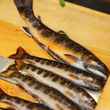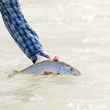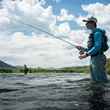“Where can I catch a big trout?”
I sometimes field this query from fishing friends who seemingly mistake me for someone smart enough to know and dumb enough to tell. Our subsequent dialogue generally transpires like a scene from All the President's Men:
Follow the money.
What do you mean? Where?
Oh, I can't tell you that.
But you could tell me that.
No, I have to do this my way. You tell me what you know, and I'll confirm. I'll keep you in the right direction if I can, but that's all. Just ... follow the money.
Whereas Deep Throat instructed Bob Woodward to follow the money, I direct my angling investigators to follow the oxygen. Trout, you see, consume oxygen like politicians devour money. Find one, and you will surely find the other.
From an angler’s perspective, the oxygen content of water is determined by temperature and turbulence. The temperature dependence is governed by something called Henry’s Law. In simplified terms, the amount of oxygen in water decreases as the temperature increases. Freezing water at the standard sea-level barometric pressure contains about fourteen milligrams of oxygen per liter. At sixty degrees Fahrenheit, the oxygen concentration falls to about ten milligrams per liter. It’s down to about nine milligrams per liter at seventy degrees Fahrenheit. These concentrations are typical of calm, stationary water, though, and for the same reason swirling a spoon in your cup causes your coffee to absorb more sugar, the turbulent water around waterfalls and riffles generally contains more oxygen than the stagnant and slow-moving parts of a river or stream. Find a river with cool, fast-moving water, and you’ll find more oxygen. Find more oxygen, and you’ll find more trout.
More Like This
All other things being equal, trout require more oxygen and, hence, cooler water than more heat-tolerant species like smallmouth bass and northern pike. So when Earth’s mid-summer tilt inevitably provokes the water temperatures to rise above seventy degrees Fahrenheit, the abundance of these more resilient fish can maintain sanity and preserve domestic tranquility for a trout fisherman stricken with the acute despair induced by an unwelcome expansion of mercury.
As happens each year, the high summer heat scorched the Upper Peninsula’s rivers and streams for several weeks straight when I decided to drive south to spend a day casting for bass and pike. Most of the nearby rivers and streams flow into Lake Superior, but a diverse array of Lake Michigan’s tributaries drains the southern part of the peninsula. Many of those—though marginal for trout during the hottest summer months—provide excellent fishing for bass, pike, and other fish that John Voelker uncharitably categorized as members of the lobster family. It was on one of those rivers—while attempting to convince some feisty bass to assault a four-inch-long counterfeit sculpin—where I learned all other things are not always equal.
Because my streamer inventory was sparse, I tied three Madonnas the previous night—simple flies with a pearl-flash under-body, a rabbit-strip over-body, and a deer-hair collar and head. I had a few other scraggly streamers I could use in a pinch, but I hoped these three would get me through the day.
My preferred method for fishing streamers is with a sinking line and the jerk-strip retrieve that Bob Linsenman and Kelly Galloup pioneered in their book Modern Streamers for Trophy Trout. In the book’s foreword, Jerry Dennis proclaims, “It might not make you give up dry flies and floating lines, but as sure as the day is long it will make your previously unproductive hours more productive.” My thoughts exactly.
The first two bass that attacked the Madonna missed. Part of the fun of this method is that, when done correctly, you can usually see the streamer—and any accompanying assault—throughout the retrieve. It is a visual sport. The first hookup, though, came when the streamer was out of sight, and the short-lived battle that followed reduced my streamer squadron to two. Seeing the line cut so neatly, I suspected a pike had cleaned me out. Two more pike and my Madonna inventory would be gone.
The first fish I landed was a chunky smallmouth that devoured the fly just as it hit the water, before I had jerked or stripped. Ten minutes later, I was onto another, and my ear-to-ear grin divulged a no matter what happens next, this outing will be successful attitude that controlled my consciousness. The next fish broke off, but the end of my line was branded with the telltale curl of a defective knot. I attached my last Madonna, double-checked the knot, then checked again.
I waded downstream toward a fishy-looking run, launched the yellow Madonna across the river, and began to jerk and strip. A massive torpedo slashed at the fly and missed just as I started one of the jerks, leaving me paralyzed by the surprise of the assault. When I moved the streamer again, the fish responded with another savage strike. Again, no hookup, but this behavior—coupled with my estimate that the fish was well over two feet long—convinced me the antagonizer was a pike.
Because a pike often attacks a fly on successive casts, I had to make a decision. I could lose my last Madonna to this pike or move beyond the toothy brute's lair. What the heck? Pike can be great fun to hook and fight, so I threw caution to the wind, and my fly followed.
The attack was spectacular and ferocious, with shrapnel of water, slime, and scales exploding across the river's surface. All my senses signaled I had hooked a two- to three-foot pike. For an instant, I even believed I smelled the musty stench I’d come to associate with pike. Then, after our brief but tumultuous introduction, the fish bolted toward Lake Michigan.
I was unreasonably calm at this point, mostly in preparation for the inescapable moment when a sharp fang liberated my last Madonna from my line. Something about this pike, though, was different. Its head shakes were heavier, and its pulls were longer than those of other pike I'd fought of its size. After much reeling and wading, I eventually closed the distance to the fish and was close enough to see its back when it slowly broached the surface. The sight of a brown trout's telltale freckles induced a sudden strike of incontinence.
My first attempt to land the fish was an embarrassing display of unprepared ineptitude. The widest opening of my landing net was 15 inches, and—with my ability to execute simple arithmetic temporarily suspended—I foolishly used the net to scoop a fish roughly twice its length. The result was exactly what a more reasonable person would have foretold—both times I tried. A butterfly net would have worked as well.
I dropped my overmatched net, shifted the rod to my right hand, and awkwardly crammed my left hand into a mesh fish-handling glove (I’ve learned in the many years since that mesh fishing gloves are anathema to successful catch and release, thanks in no small part to the fact that they function as a sort of paint-stripper. Only, instead of stripping paint, they strip fish of their protective mucus, putting them at increased risk of all kinds of infections). The fish was still close, but—sensing the same danger I feel when my doctor crams his hand into a latex examination glove—the fiend made a desperate dash straight toward me and through my legs. A Salmo trutta variant of mano-a-mano.
The defunct net hung from my waist and dragged like a drift sock in the water; my left hand sported the inelegant mesh glove, making it useless for, well, just about anything; my right hand held the fly rod above my head, and the 8-foot bamboo buggy whip was bent in a near-complete circle down toward my crotch. Line sped through my legs in response to the trout's ascent toward its goal of kissing my clumsy derriere goodbye. I swung one of my legs over the line and returned to some semblance of a proper fish-fighting position. Despite the mesh mitten on my line-handling hand, I again closed my distance to the fish. Then el toro launched another charge through the legs of el torero, and we repeated the whole crazy scene.
The fish and I shortened our distance one final time, though this time I feared it was the fish that had initiated the maneuver. My first seize of its tail held for about one second. My next grab lasted two. My third stuck just as my footing failed, but this time I hung on. I fell to my knees and found myself eye-to-eye with the fish whose silver body stretched twenty-eight inches from the tip of its tail to the tip of its nose. After a few clumsy photographs, I released the lake-run behemoth and moved to the safety of the shore where the fish could not make another vengeful run at my knees. Both the Madonna and I were a tattered mess. Either, or both, would surely fall apart if we attempted another cast, so I declared that our day was done.
Now, when someone asks me where they can catch a big trout, I tell them to follow the oxygen. Unless they want to catch a really big trout. Then I tell them to head south and fish for bass in marginal water for trout.































Comments
Rip Woodin replied on Permalink
Not very good but excellent descriptive writing, especially "a sudden strike of incontinence."
Pages